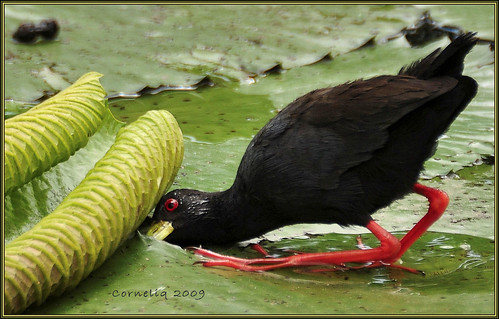
Indian animals of black crake birds posters

free downloading of black crake wikipedia

latest pics of black crake youtube
african animals of black crake pictures
The adult Black Crake is 19–23 cm long with a short tail and long toes. As its name implies, the adult has mainly black plumage, with a brown olive tone on the wings and upperparts which is rarely detectable in the field. The eye is red, the bill is yellow (hence the flavirostra of the binomial name), and the legs and feet are red, duller when not breeding.The sexes are similar, but the male is slightly larger. Most males, but only 10% of females, have a hooked upper mandible. The immature bird has brown upperparts and a dark grey head and underparts. Its bill is greenish yellow, and its feet and legs are dull red. The downy chicks are black, as with all rails.The main call of the Black Crake is a duet, starting with a throaty chattering krrrok-kraaaa. The response is a dove-like cooing coo-crr-COO.
The habitat of this common to abundant species is freshwater marshes of all types, as long as there is some vegetation to provide cover. Many rails are very secretive, but the Black Crake is often seen out in the open. It has benefited from human activity in the form of deforestation, and is rarely hunted because of its unpalatable flesh.
The nest is a deep neat bowl made from wetland plants and built by both sexes in marsh vegetation or on the ground in a dry location. The nest is also sometimes constructed up to 3 m high in a bush.The two to six, usually three, eggs are cream or white, and spotted with brown or chestnut. Both parents, sometimes assisted by the young from previous broods, incubate for 13–19 days to hatching. The precocial chicks leave the nest in 1–3 days, but are fed by parents and helpers for several weeks. They can fly by 5–6 weeks, and are independent at 6–12 weeks.click for beautiful places...
The nest is a deep neat bowl made from wetland plants and built by both sexes in marsh vegetation or on the ground in a dry location. The nest is also sometimes constructed up to 3 m high in a bush.The two to six, usually three, eggs are cream or white, and spotted with brown or chestnut. Both parents, sometimes assisted by the young from previous broods, incubate for 13–19 days to hatching. The precocial chicks leave the nest in 1–3 days, but are fed by parents and helpers for several weeks. They can fly by 5–6 weeks, and are independent at 6–12 weeks.click for beautiful places...
No comments:
Post a Comment